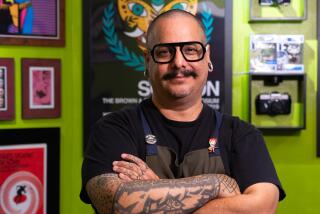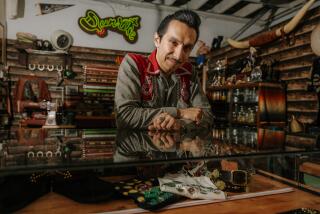La Jolla Woman Hit the Trail, Brought Back Gaucho Clothes, Culture
- Share via
LA JOLLA — Mary Moore Little met a gaucho at an airport, fell in love with him and followed him to Argentina.
For weeks she searched for him in antique shops and bookstores, and one day found him in a little town outside Buenos Aires. Since she had taken a crew with her to film a celebration, she made a film of him riding his swift horse bedecked with silver across the plains.
Then she came home and, possessing only a few mementos from her trip, tried to turn her gaucho’s image into a women’s fashion craze.
As unlikely as that scenario sounds, it’s a fairly good description of what Little, a longtime resident of La Jolla, has been doing for the last 14 months.
The gaucho Little pursued in Argentina was a mythical one; by that time she had become obsessed with the history, traditions and even the machismo of the gauchos. (Gauchos are cowboys of mixed Indian and Spanish ancestry, living on the South American pampas.) But the gaucho she met at the airport--the one who initially sparked her interest--was very real. “His name was El Tio (the uncle), and he represents Argentina at cultural functions,” Little said.
Upon seeing El Tio at Brazil’s Sao Paulo airport last year, Little became enthralled by his traditional wardrobe.
“I started taking pictures of him while I was waiting for my luggage,” she said. “I painted a watercolor of him, too, and had him sign it.” But all the time she had her eyes on his belt.
Gaucho belts are made of silver and gold; they’re broad and heavy and often decorated with chains and coins. “I kept thinking, ‘I’ve got to get one of those for myself. It would look wonderful with a tweed suit,’ ” Little said. “And then later I realized it had to be a whole fashion look.”
Thus began her obsession with gaucho clothes and culture. Within two months, Little was in Argentina, looking for gaucho belts and almost anything else that gauchos had worn, used or inspired, including records and books. Overnight she had become a gauchophile.
Some of the objects she found were exhibited in December at the Costume Institute at the Metropolitan Museum of Art in New York, and 30 of Little’s antique gaucho belts will be on display at the Beverly Hills Neiman-Marcus store today and Saturday.
Traveling to Argentina because of a chance meeting at an airport might seem like an impulsive act. But Little is nothing if not impulsive.
When she owned the Mary Moore Gallery in La Jolla from 1971 to 1975, Little said, she relied on her instincts to exhibit the works of little-known but important new artists such as Fritz Scholder, Francisco Toledo and Francois Gilot Salk.
“I always chose artists that were instinctively important to me, and I’ve followed that conviction in other things, too,” she said.
“When I saw this gaucho . . . I wasn’t thinking in terms of fashion. He was a very romantic figure, with a gorgeous look about him. There hasn’t been anything that captured my attention like that since I closed my gallery. But sometimes you know something is great, but you don’t know the application.”
Little flew to Buenos Aires last November, and, with the help of cultural attaches from the American Embassy and an Argentinean guide, began searching for gaucho paraphernalia in antique stores and flea markets. She quickly learned that much of the gaucho’s traditional culture has disappeared, along with most of the belts.
“Gauchos are disappearing. They lived almost like vagabonds,” Little said, noting that gauchos and their families once wandered across the pampas in horse-drawn coaches that resembled covered wagons. “They were pioneer people, herding cattle. But the English introduced barbed wire on the pampas, so (the gauchos) couldn’t roam freely any more. Some became ranchers, but the rest--the few that are still there--are almost like ranch hands.”
“It’s like they’re forgotten heroes,” she added, explaining that gauchos figured importantly in the Argentine struggle for independence against Spain. “People know about them, but . . . “
Although many of the finest gaucho belts are now in museums and private collections, Little managed to buy about 30 antique belts. All are made of silver and gold, and nearly all bear favorite symbols of the gauchos, such as eagles, hearts and pampas flowers. Many are also adorned with antique coins--symbols, Little said, of the owner’s wealth and independence: “It was money they had but didn’t need to spend.”
While in Buenos Aires, Little learned of the Day of Tradition in the small town of San Antonio de Areco, a unique celebration in which gauchos compete against each other in various events on horseback. She went to the celebration and took an Argentinean film crew. It was another impulsive act, because she had no specific plans for the resulting seven-minute film. “I just do things gung-ho,” she said. “I love films, and it was something I hadn’t done.”
After three weeks in Argentina, Little flew to New York with her antique gaucho belts and began negotiating with a belt manufacturer to mass-produce similar belts. For a time she dreamed of an entire fashion and accessory line of gaucho products, including perfume in bottles with little gaucho hats for lids.
But the belts proved to be too costly and difficult for the manufacturer to reproduce, and rather than contact other manufacturers, Little has decided to sell the belts and move on to something else.
“I don’t want to produce gaucho belts the rest of my life. I like to get excited about something and then move on to the next project. It’s not in my temperament to stick with things,” she said.
“I’ve always done the things I felt like doing, but I’m a failure at the usual things--like business.”
Since then, gaucho belts--or, at least, heavy silver belts decorated with chains and coins--have become a popular fashion item. Argentinean President Raul Alfonsin and his wife gave one to President and Mrs. Reagan during a March visit to the United States, and, according to Little, similar belts have appeared at recent Paris fashion shows.
Although she expects imitation gaucho belts to be “knocked off like crazy” in the coming months, Little said she isn’t sorry she won’t cash in on the trend. “I guess I was just a little ahead of the (trend). . . . but I’m happy that I could bring the gaucho to people’s attention. Everything about them is interesting to me,” she said.
Little plans to sell her antique gaucho belts for prices ranging from a few thousand dollars to more than $10,000. “They’re expensive, but they’re (among) the last ones in the world,” she said.
“To tell you the truth, I wish someone would just come to me and say, ‘I want to keep these in a museum.’ That would be better. They’re really more like museum pieces than belts.”
If she does sell the belts, Little will still have other mementos of her trip, including a gaucho teacup made from a hollow gourd, gaucho spurs made of silver and several antique books about gauchos--not to mention her seven-minute film of the gauchos and their horses at the Day of Tradition.
“I got obsessed,” she said frankly.
More to Read
Sign up for Essential California
The most important California stories and recommendations in your inbox every morning.
You may occasionally receive promotional content from the Los Angeles Times.










